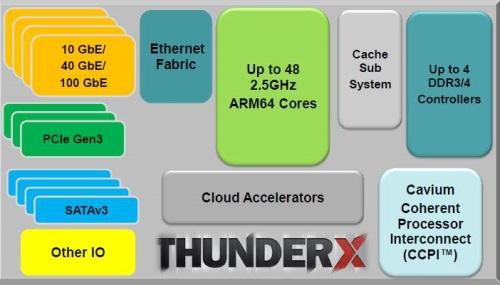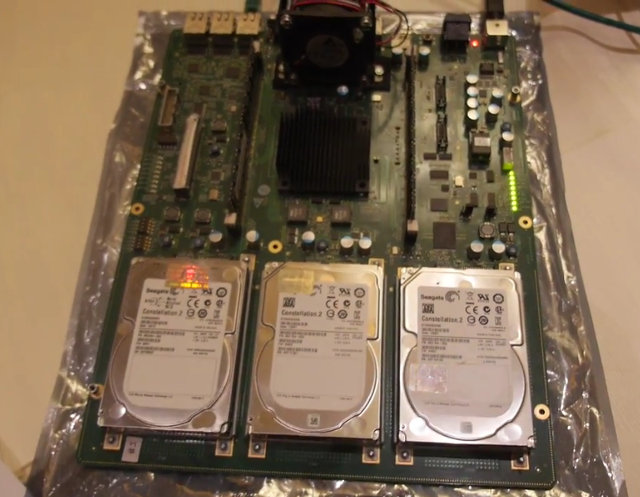We’ve already seen development board such as X-Gene XC-1, and 64-bit ARM servers have been demonstrated by Dell and HP, but SoftIron, a British startup, claims to be the first to provide a production ready ARMv8 solutions for the enterprise server market (e.g. data centers), with its SoftIron 64-0400 and 64-0800 server motherboards powered by Applied Micro X-Gene quad and octa SoC. Although the company did not release complete pictures of the board, they seem to have done a better job with specifications: SoC SoftIron 64-0400 – Applied Micro X-Gene APM883204 with 4x 64-bit ARMv8 cores @ 2.4 GHz, 4x 32-bit ARMv5 cores for Network/Security offloads and Acceleration, and 1x Cortex M3 for server management SoftIron 64-0800 – Applied Micro X-Gene APM883208 with 8x 64-bit ARMv8 cores @ 2.4 GHz, 4x 32-bit ARMv5 cores for Network/Security offloads and Acceleration, and 1x Cortex M3 for server management System Memory – Up […]
Cavium ThunderX Server SoC Features up to 48 ARM 64-bit Cores
ARM SBSA specification for server supports up to 268,435,456 CPU cores for the second level of standardization on one or a combination of SoCs. We’re not quite up there just yet, but Cavium ThunderX is an ARM server SoC with up to 48 cores on a single chip, which is the highest number of cores I’ve ever heard of in an ARM SoC. The company created their own custom processor cores using an ARMv8 architecture license, designing an SoC complies with ARM’s Server Base System Architecture (SBSA) standard with the following key features: ARM based SoC that scales up from 8 to 48 cores with up to 2.5 GHz core frequency with 78K I-Cache, 32K D-Cache, and 16MB L2 cache. Fully cache coherent across dual sockets using Cavium Coherent Processor Interconnect (CCPI) Integrated I/O capacity with 100s of Gigabits of I/O bandwidth 4x DDR3/4 72-bit memory controllers supporting up to 1TB RAM […]
Prpl Non-Profit Organization to Work on Linux, Android, and OpenWRT for MIPS based Processors
In what looks like an answer, albeit fairly late, to Linaro, the non-profit organization working on open source software for ARM based SoCs, a consortium of companies composed of Imagination Technologies, Broadcom, Cavium, Lantiq, Qualcomm, Ingenic, and a few others, has funded Prpl (pronounced Purple), “an open-source, community-driven, collaborative, non-profit foundation targeting and supporting the MIPS architecture—and open to others—with a focus on enabling next-generation datacenter-to-device portable software and virtualized architectures”. The Prpl foundation will focus on three key objectives: Portability – To create ISA agnostic software for rapid deployment across multiple architecture Virtualization & security – To enable multi-tenant, secure, software, environments in datacenter, networking & storage, home, mobile and embedded Heterogeneous Computing – To leverage compute resources enabling next generation big data analytics and mining Initially there will PEG (Prpl Engineering Group) to take of the following projects for 4 market segments (datacenter, network & storage, connected consumers, […]
How to Boot a Headless Linux Image on Amlogic S802 TV Boxes (Tronsmart Vega S89 Elite)
As some of you already know, I’ve been playing around with Tronsmart Vega S89 Elite, an Android TV Box powered by Amlogic S802 quad-core ARM Cortex A9r4 processor at 2 GHz. Today, I’ll show how to boot a headless Linux image on any Amlogic-based S802 TV Box from the network. The instructions can mainly be used as a starting point for developers, as it requires access to a serial terminal via UART, but if you’ve never done it before, the instructions should be easy enough to follow. Everything is loaded from the network, the kernel (via boot.img) is loaded via TFTP, and the rootfs (Linaro ALIP image) is mounted via NFS, so it’s nearly impossible to brick your device using the method provided. Linaro ALIP rootfs comes with LXDE, but at this stage, the desktop environment is not showing, even though my HDMI TV is properly detected by the drivers. […]
AMD Announces ARM and x86 pin-to-pin Compatible APUs and SoCs for 2015, ARM K12 Core for 2016 and Beyond
AMD has designed x86 processor since its inception, and recently they’ve announced ARM Cortex A57 “Seatlle” SoCs targeting servers would be available later this year. They’ve now decided to merge their product line-up even further with Project Skybridge that aims to provide pin-to-pin compatible ARM and x86 SoCs and APUs by 2015, manufactured using a 20nm process. That means AMD’s customers should be able to leverage AMD’s “ambidextrous computing” solutions to design one and only board for x86 and ARM processors for server, embedded, semi-custom and ultra-low power applications. Processors of the “Project Skybridge” family will also be the first ARM based AMD processors to include a GPU (Graphics Core Next GPU), contrary to Seatlle SoCs, which are destined to be used for the server market, and do not come with a GPU. ARM processor will be based on low power ARM Cortex A57 cores and x86 processors will make […]
Huawei D01 Server Board Features 16 ARM Cortex A15 Cores with up to 64 GB RAM, 3 SATA, 2 GbE Ports
During Linaro 14.02 release, I noticed a Huawei D01 board with 16 ARM Cortex A15 core, but details were lacking. Charbax was a Linaro Connect Asia earlier this month, and he could film the board in action, and interview the development team about this server board, and software development. Huawei D01 specifications: Processor HiSilicon SoC with16 x ARM Cortex-A15 CPU Core @ max. 1.5GHz (up to 84000 DMIPS) Support for CPU configuration as AMP/SMP Configurable Big or Little endian. Default: Little endian System Memory – 2x 64bit DDR3 DRAM Dual Inline Memory up to 1600 MHz, Module(DIMM) sockets:(2)&(3) . Default capacity: 8GB, upgradeable to 64GB Storage – 2x 1Gb NOR Flash, 2x 512MB NAND Flash, 3x SATA III for 2.5″ hard drives or SSD, 1x SD card Connectivity – 2x 10/100/1000Mbit/s Gigabit Ethernet ports, 1x 10/100Mbit/s FE port Other Peripheral Interfaces 2x USB 2.0 Host ports 2x UART, 4x I2C, […]
Dedicated Hosting Services on ARM Development Boards (Cubieboard2, Raspberry Pi, ODROID…)
At least two companies have recently launched hosting services using dedicated ARM servers based on low cost development boards: NanoXion with its NX-BOX service powered by PiBox (Raspberry Pi) and CubieBox (Cubieboard 2) microservers, and miniNodes with servers based on Cubieboard2 first, then ODROID development boards, and possibly AllWinner OptimusBoard once/if it becomes available. The PiBox will feature a Raspberry Pi Model B with 512 MB RAM, and 16GB Class 10 UHS-1 microSD card by Samsung, and the dual core Cubiebox comes with 1GB RAM and a Crucial M500 SATA III 120GB SSD. Both NX-BOXes run Linux Debian Server NX distribution, support instant remote reboot, with guaranteed 10 Mbps connectivity for IPv4 & IPv6, and unlimited bandwidth. The boards are all hosted in France. The company expects their ARM servers to be used as private cloud servers, backup servers, private chat servers, web servers, mail servers, DNS Servers, monitoring servers, and […]
PC Engines APU System Boards Feature AMD G-Series T40E APU, 3 Gigabit Ethernet Ports
Up to now there were basically two embedded board based on x86 architecture available to hobbyists: Gizmo Board (AMD T40E) and Minnowboard (Intel Atom). There’s now another solution with PC Engines system boards, namely APU.1C and APU.1C4, that comes with AMD G-Series T40E dual core APU, 2 to 4 GB RAM, 3 Gigabit Ethernet ports, an mSATA connector, and more. Contrary to the other two boards however, there’s no video output, and that makes these APU boards suitable for routers, firewalls, VOIP, dedicated servers, special purpose network plumbing, etc.. PC Engines APU boards specifications: APU – AMD G -Series T40E dual core APU @ 1 GHz with 64 bit support, 32K data + 32K instruction + 512KB L2 cache per core, with Radeon HD6250 GPU. System Memory APU.1C – 2 GB DDR3-1066 DRAM APU.1C4 – 4 GB DDR3-1066 DRAM Storage – SD card (connected through USB), m-SATA, and one SATA […]










